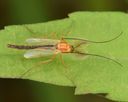Chironomus
Chironomus
Classification
- Phylum: Arthropoda
- Subphylum: Hexapoda
- Class: Insecta
- Order: Diptera
- Infraorder: Culicomorpha
- Family: Chironomidae
- Subfamily: Chironominae
- Tribe: Chironomini
- Genus: Chironomus
Pronunciation
How to pronounce Chironomus: /kɪˈrɒnəməs/
These audio files are automatically generated. While they are not always 100% accurate, they are a good starting point.
Images






Summary
Chironomus is a genus of nonbiting midges associated with aquatic environments, with distinctive features including their habitat preferences and physical characteristics. They have several species that are cryptic, making identification challenging for non-experts.
Physical Characteristics
Adults range from 5 to 13 mm in length. The pronotum is widest in the middle and bears a notch. Heads typically have a pair of small tubercles above the antennal bases. Male flagellum has 11 segments, and the inferior volsella of male genitalia is large and larger than the superior.
Identification Tips
Adult males can be distinguished from females by their feather-like antennae. Specific features of the giant chromosomes may be used by experts to identify cryptic species within the genus.
Habitat
Larvae typically inhabit aquatic sediments. They can be found in both highly nutrient-rich, low oxygen environments as well as relatively clean water.
Distribution
Most of North America and other parts of the world.
Diet
Larvae and adults are usually detritivores, feeding on organic matter found in their aquatic habitats.
Ecosystem Role
Chironomus larvae can serve as important bioindicators of ecological health in aquatic systems and are vital in nutrient cycling.
Evolution
The name Tendipes Meigen was historically used for Chironomus but was suppressed in favor of the traditional name Chironomus based on nomenclatural rules in 1963.
Misconceptions
Some believe all midges are biting; however, Chironomus midges are nonbiting.
Tags
- midges
- Chironomidae
- aquatic insects
- nonbiting
- larvae